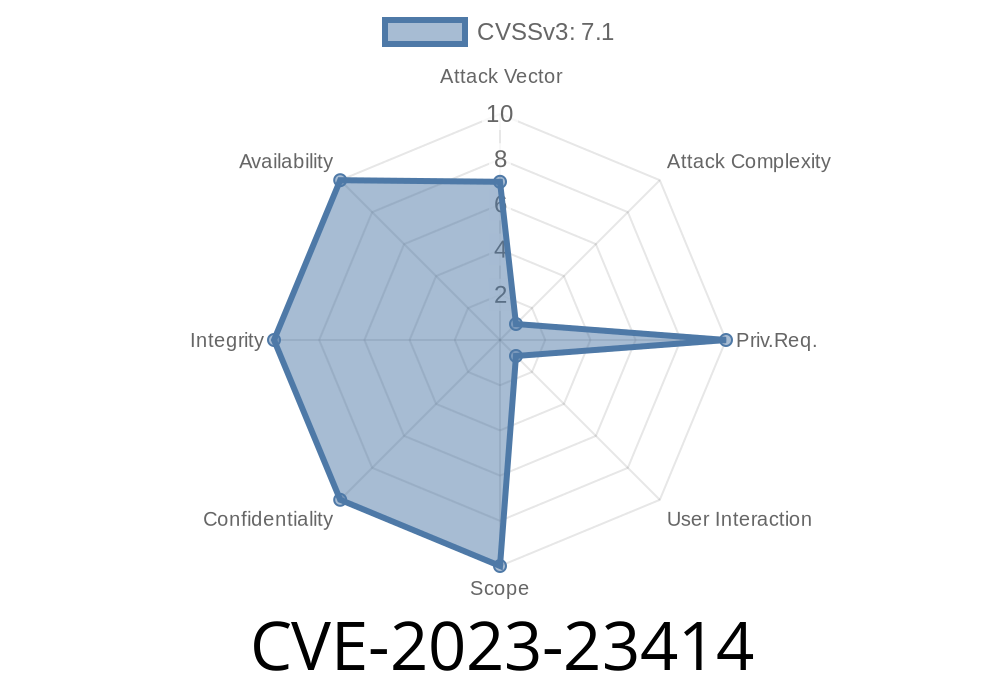Security researchers have recently discovered a critical vulnerability, CVE-2023-23414, in the Windows Point-to-Point Protocol over Ethernet (PPPoE) - a widely used method for establishing network connections in various Windows operating systems. The vulnerability allows a remote attacker to exploit the flaw and execute arbitrary code on a victim’s machine, potentially granting complete control over the system. In this post, we'll walk through the technical details of this vulnerability, provide links to the original references, and explore the possible exploit scenarios to better understand the potential impact.
CVE-2023-23414 Overview
CVE-2023-23414 has been classified as a critical remote code execution vulnerability. It affects the Windows PPPoE implementation, which is commonly used for establishing Internet connections, particularly on Digital Subscriber Line (DSL) and some wireless networks.
A detailed description of the vulnerability can be found in the Common Vulnerabilities and Exposures (CVE) database at this link: https://cve.mitre.org/cgi-bin/cvename.cgi?name=CVE-2023-23414
The official memorandum by Microsoft addressing the issue and providing a patch can be found here: https://portal.msrc.microsoft.com/en-US/security-guidance/advisory/CVE-2023-23414
Code Snippet
The vulnerability exists due to improper handling of specific packets within the PPPoE protocol. When a specially crafted packet is received, a buffer overflow occurs, leading to arbitrary code execution.
The following code snippet illustrates a simplified example of this vulnerability
void process_packet(char *packet_data, int data_length)
{
char buffer[256];
// ... PPPoE packet processing code ...
if (data_length > sizeof(buffer))
{
printf("Error: Data length too long!");
return;
}
memcpy(buffer, packet_data, data_length); // <-- buffer overflow vulnerability!
// ... Further processing of the packet ...
}
In this example, the PPPoE packet is being processed by the process_packet function. The function does not correctly validate the data_length before copying data to the buffer, which allows for a buffer overflow.
Exploit Details
An attacker can exploit this vulnerability by sending specially crafted packets to the target system. As the packets are processed by the vulnerable PPPoE service, the attacker’s arbitrary code is executed, potentially allowing the attacker to gain control of the victim’s machine.
To exploit this vulnerability, an attacker would first need to craft a malicious PPPoE packet containing their desired payload. This could be accomplished using a tool like Scapy, a popular packet crafting utility for Python:
from scapy.all import *
# Creating a malicious packet with a large payload
ip_hdr = IP(dst="target_IP_address")
pppoe_hdr = PPPoE()
payload = "A" * 300 # Replace with your desired payload
malicious_pkt = ip_hdr/pppoe_hdr/payload
send(malicious_pkt)
Upon successfully executing the payload on the victim's machine, the attacker could gain full control over the compromised system.
Conclusion
CVE-2023-23414 represents a severe threat in the Windows operating system PPPoE implementation. The vulnerability allows remote code execution by an attacker through crafted packets sent to the target. System administrators and individual users alike should ensure their systems are patched with the latest security updates provided by Microsoft to mitigate this risk. The publication of this vulnerability further highlights the need for increased vigilance in securing network protocols and services against potential exploitation.
Timeline
Published on: 03/14/2023 17:15:00 UTC
Last modified on: 03/23/2023 16:55:00 UTC
